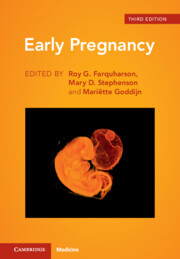Book contents
- Early Pregnancy
- Early Pregnancy
- Copyright page
- Contents
- Contributors
- Chapter 1 Novel 3-D Imaging Techniques in Early Pregnancy
- Chapter 2 What Is Endometrial Receptivity?
- Chapter 3 Pathophysiology of Chronic Endometritis
- Chapter 4 Clinical Management of Chronic Endometritis in Recurrent Pregnancy Loss
- Chapter 5 Implantation
- Chapter 6 Early Placental Development and Disorders
- Chapter 7 The Uncertain Science of Preimplantation Genetic Testing for Reproduction
- Chapter 8 Thyroid Physiology and Early Pregnancy
- Chapter 9 Early Pregnancy Core Outcomes
- Chapter 10 Thyroid Treatment Trials
- Chapter 11 Müllerian Duct Development, Diagnosis and Management of Anomalies
- Chapter 12 Candidate Genes in Pregnancy Loss
- Chapter 13 Inherited Thrombophilia
- Chapter 14 Guidelines on the Diagnosis and Management of Sporadic Miscarriage
- Chapter 15 Investigation of Recurrent Pregnancy Loss
- Chapter 16 Talking with Patients about Pregnancy Loss
- Chapter 17 Psychological Support after Pregnancy Loss
- Chapter 18 Tubal Ectopic Pregnancy and Pregnancy of Unknown Location
- Chapter 19 Medical Management of Tubal Pregnancy
- Chapter 20 Candidate Biomarkers for Prediction of Pregnancy Location and Viability
- Chapter 21 Diagnosis and Management of Extrauterine Pregnancies
- Chapter 22 Ultrasound to Diagnose and Predict Early Pregnancy Outcome
- Chapter 23 Molar Pregnancy
- Chapter 24 COVID and Early Pregnancy
- Chapter 25 Obstetric and Perinatal Outcome after Assisted Reproductive Technology Pregnancy Events and Complications
- Chapter 26 Obesity and Early Pregnancy
- Chapter 27 Dynamic Prediction Models for Recurrent Pregnancy Loss
- Chapter 28 Pregnancy Loss: From Cytogenetics to Genomics
- Chapter 29 Progesterone Use in Early Pregnancy
- Index
- References
Chapter 27 - Dynamic Prediction Models for Recurrent Pregnancy Loss
Published online by Cambridge University Press: 16 April 2025
- Early Pregnancy
- Early Pregnancy
- Copyright page
- Contents
- Contributors
- Chapter 1 Novel 3-D Imaging Techniques in Early Pregnancy
- Chapter 2 What Is Endometrial Receptivity?
- Chapter 3 Pathophysiology of Chronic Endometritis
- Chapter 4 Clinical Management of Chronic Endometritis in Recurrent Pregnancy Loss
- Chapter 5 Implantation
- Chapter 6 Early Placental Development and Disorders
- Chapter 7 The Uncertain Science of Preimplantation Genetic Testing for Reproduction
- Chapter 8 Thyroid Physiology and Early Pregnancy
- Chapter 9 Early Pregnancy Core Outcomes
- Chapter 10 Thyroid Treatment Trials
- Chapter 11 Müllerian Duct Development, Diagnosis and Management of Anomalies
- Chapter 12 Candidate Genes in Pregnancy Loss
- Chapter 13 Inherited Thrombophilia
- Chapter 14 Guidelines on the Diagnosis and Management of Sporadic Miscarriage
- Chapter 15 Investigation of Recurrent Pregnancy Loss
- Chapter 16 Talking with Patients about Pregnancy Loss
- Chapter 17 Psychological Support after Pregnancy Loss
- Chapter 18 Tubal Ectopic Pregnancy and Pregnancy of Unknown Location
- Chapter 19 Medical Management of Tubal Pregnancy
- Chapter 20 Candidate Biomarkers for Prediction of Pregnancy Location and Viability
- Chapter 21 Diagnosis and Management of Extrauterine Pregnancies
- Chapter 22 Ultrasound to Diagnose and Predict Early Pregnancy Outcome
- Chapter 23 Molar Pregnancy
- Chapter 24 COVID and Early Pregnancy
- Chapter 25 Obstetric and Perinatal Outcome after Assisted Reproductive Technology Pregnancy Events and Complications
- Chapter 26 Obesity and Early Pregnancy
- Chapter 27 Dynamic Prediction Models for Recurrent Pregnancy Loss
- Chapter 28 Pregnancy Loss: From Cytogenetics to Genomics
- Chapter 29 Progesterone Use in Early Pregnancy
- Index
- References
Summary
In the absence of evidence-based therapeutic options for the majority of couples with recurrent pregnancy loss (RPL) it is considered significant to offer supportive care, including reliable counseling regarding the prognosis of subsequent pregnancies. Currently, various prediction models are available, with a focus on couples with unexplained RPL. All of them having drawbacks like substantial risk of bias, lack of performance measures and applicability. A new prediction model, using more predictors, such as male predictors and focusing on cumulative live birth rates over a reasonable time period is currently needed. In addition, this model should have the ability to provide reliable predictions at later time points, a so-called dynamic prediction model.
- Type
- Chapter
- Information
- Early Pregnancy , pp. 292 - 298Publisher: Cambridge University PressPrint publication year: 2025

